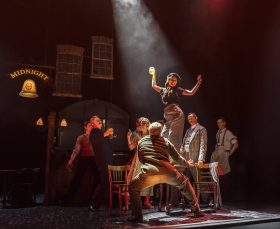There`s a decided irony and one which probably would amuse Marilyn Monroe herself that La Diva is more famous now that she`d dead than she was even during her own lifetime.
The National Portrait Gallery ran an exhibition of Andy Warhol`s work in October 2007-January 2008 in which the Marilyn silkscreens featured prominently. Warhol began the portraits following the death of the actress and reflect his recurrent theme (especially in the actress silkscreens) of moribundity and decay. They are not thus amongst my favourite Marilyns. I prefer the great photos of Halsmann, Cecil Beaton and Jack Cardiff (some in the permanent collections of the National Portrait Gallery) Bert Stern`s synthetic Marilyn still remains my absolute favourite – the Marilyn sending up her own image as Barbi doll replete with dynel wig and yonks of makeup.
Willy Russell has been using Marilyn as an icon in `Blood Brothers` for years and now Bonnie Greer has revised a radio play (I think) for the theatre and `Marilyn and Ella` has been running in March 2008 at the Theatre Royal, Stratford. The actress playing Marilyn looks about age 45 (maybe older) whilst Marilyn herself, at the time of the play (1955), was only age 29.
The play, largely fiction, is probably Greer`s attempt at rendering something about the feminist Marilyn. Unfortunately her knowledge of Monroe- of Hollywood women- is as pitifully limited as her information about a friendship between Marilyn and Ella and she conjectures that Marilyn was ahead of her time having begun her own production company subsequent only to Mary Pickford.
The fact is actresses such as Lillian Gish (when she made films abroad), Ida Lupino (one of the founders of Four Star) and others had their own production companies and actresses like Olivia deHavilland and Bette Davis fought the majors about suspension thus forging a way for the seven-year contract.
If Marilyn was active in Hollywood politics, she certainly was not as involved as Betsy Blair who was blacklisted because of her commitment to the Screen Actors Guild sub-committee on improved roles for Blacks. If she was political, she wasn`t as visible as Lauren Bacall or Humphrey Bogart who marched on Washington in support of the blacklisted Hollywood 18.
What she probably did amidst the winds of McCarthy doom was to cajole the owner of the restricted Mocambo nightclub in Los Angeles into hiring the great Ella Fitzgerald (who despite being the greatest scat singer of all time was nevertheless banned because she was Black). Marilyn promised to take a front row table every night of Ella`s run which, given her popularity in 1955, was sure to engender massive publicity.
Quoted about it, Ella said, `I owe Marilyn Monroe a real debt. It was because of her that I played the Mocambo. SHe personally called the owner and told him she wanted me booked immediately and if he`d do it she`d take a front table every night. The press would go wild. After that I never had to play a small jazz club again. She was an unusual woman- a little ahead of her time. And she didn`t know it`.
How true. How true.
Working in small, interpersonal ways, Marilyn accomplished some pretty significant things not the least of which was her defiant stand with playwright Arthur Miller at the time he was being summoned before HUAC. They married during the height of the very ordeal and honeymooned in England in 1956 whilst she was filming `The Prince and the Showgirl` for her own production company. (See Sandra Shevey, `The Marilyn Scandal`, 2007)
If you want to talk about Marilyn`s friendship with a Black performer, talk about Dorothy Dandridge who along with Ava Gardner, James Dean and Marlon Brando formed part of a Hollywood clique in the late Forties and early Fifties.
Dandridge, who committed suicide in 1965, only 3 years after Marilyn, was the first Black to perform at the restricted Waldorf-Astoria hotel in New York City (owned by Paris Hilton`s grandfather or great-grandfather)
Like Marilyn, Dandridge was also victim of a myth that she tried unsuccessfully to elude. However, unlike Marilyn who succeeded in transforming herself from a sex symbol into a serious actress, Dandridge was stuck with the Black label of wanton and tease. Her sex allure was always predicated upon rape.
Lena Horne, my own pick as a Black actress who had she had the chance, would have clobbered both Marilyn and Elizabeth Taylor at the box office, refers to Dorothy as `our Marilyn Monroe`.
It`s like John Lennon saying to me in our 12-hour interview, `You`ve got cancer and I`ve got polio. Who can say which is worse?`
For all her advantages as a Caucasian actress and in spite of her foster home beginnings, Marilyn Monroe succeeded in surmounting the porn label and became not only an actress but a person of considerable talent and commitment.
It is only recently that America has acknowledged that it has a working class and that Marilyn Monroe is an example of someone from that class who sought to rise above her roots. This is a theme which I attempted to exploit as early as 1972 when I talked to Marshall Flaum at David Wolper Productions about doing a take on Marilyn which heretofore had not been done. Whilst he was wildly enthusiastic about the originality of the approach he could not raise the money and it remained for Sidgwick and Jackson to publish the thesis in 1987. Since then rights have been reverted and 2007 saw the reissue of `The Marilyn Scandal` via Sandra Shevey Books complete with a new cover (no photo), an updated introduction and an appendix with letters from those interviewed for the book.
If you only remember one thing about Marilyn, remember this. A year or two before she died and whilst living in Roxbury, Connecticut with Arthur Miller, her neighbours, holding her political activism in high esteem, sought to mount a campaign to run Marilyn as a candidate for the existing Democratic Congressional seat.
Not bad for a girl from the other side of the tracks?
Sandra Shevey`s revised edition of `The Marilyn Scandal` can be purchased online at sandra_shevey@yahoo.com.




